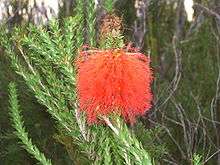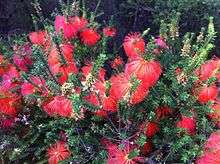Beaufortia sparsa
Beaufortia sparsa, commonly known as the swamp bottlebrush, is a plant in the myrtle family, Myrtaceae and is endemic to the south-west of Western Australia. It is an erect or spreading shrub with round, dished leaves crowded on the younger stems, and bright red flower spikes in the warmer months.
| Beaufortia sparsa | |
|---|---|
 | |
| Beaufortia sparsa growing near Albany | |
| Scientific classification | |
| Kingdom: | Plantae |
| Clade: | Tracheophytes |
| Clade: | Angiosperms |
| Clade: | Eudicots |
| Clade: | Rosids |
| Order: | Myrtales |
| Family: | Myrtaceae |
| Genus: | Beaufortia |
| Species: | B. sparsa |
| Binomial name | |
| Beaufortia sparsa | |
| Synonyms | |

Description
Beaufortia sparsa is an evergreen shrub that grows to 1–3 metres (3–10 ft) tall and 1–2.5 metres (3–8 ft) wide. The leaves are bright green, oval-shaped, flat or slightly dished, 6–12 millimetres (0.2–0.5 in) long and have many veins.[1][2][3]
The flowers are bright orange to red in colour and arranged in bottlebrush-like spikes near the ends of the branches that continue to grow after flowering. The flowers have 5 sepals, 5 petals and 5 bundles of stamens each containing about 5 stamens. The hypanthium is about 2 millimetres (0.08 in) long but the stamens, which give the flowers their colour, are up to 26 millimetres (1 in) long. Flowers are produced from January to April and from September to November and are followed by fruits which are woody capsules which are retained on the stems indefinitely.[1][2][3]
Taxonomy and naming
Beaufortia sparsa was first formally described in 1812 by Scottish botanist, Robert Brown in William Aiton's Hortus Kewensis.[4][5] The specific epithet ("sparsa") is a Latin word meaning "scattered".[6]
Distribution and habitat
Beaufortia sparsa mainly occurs between Busselton and Albany in the Esperance Plains, Jarrah Forest, Swan Coastal Plain and Warren biogeographic regions.[1] It usually grows in sand in swampy places or near watercourses.[7]
Conservation
Beaufortia orbifolia is classified as "not threatened" by the Western Australian government Department of Parks and Wildlife.[1]
Use in horticulture
Swamp bottlebrush is probably the most widely cultivated in the genus Beaufortia but it is not well known in gardens. It is difficult to grow in the more humid eastern states but in drier climates is a colourful feature.[2]
References
- "Beaufortia sparsa". FloraBase. Retrieved 24 August 2015.
- "Beaufortia sparsa". Australian Native Plants Society (Australia). Retrieved 24 August 2015.
- Bentham, George; von Mueller, Ferdinand (1867). Flora Australiensis. London: Lovell Reeve and Co. p. 165. Retrieved 24 August 2015.
- "Beaufortia sparsa". APNI. Retrieved 24 August 2015.
- Aiton, William (1812). Hortus Kewensis (Volume 4) (2 ed.). Paternoster Row: Lonhman, Hurst, Rees, Orme and Brown. p. 419. Retrieved 24 August 2015.
- Brown, Roland Wilbur (1956). The Composition of Scientific Words. Washington, D.C.: Smithsonian Institution Press. p. 744.
- Paczkowska, Grazyna; Chapman, Alex R. (2000). The Western Australian flora : a descriptive catalogue. Perth: Wildflower Society of Western Australia. p. 350. ISBN 0646402439.